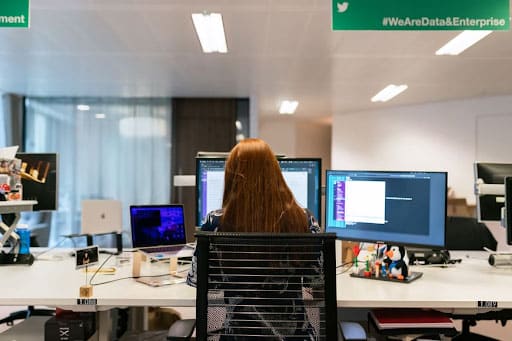
Data centers provide solutions for organizations to store, process, and disseminate their IT operations and equipment. But, according to Brendan Walsh of World Wide Technology (WWT), the carbon “emissions from data centers are now very close to those from the airline industry,” making them the fifth largest electricity consumer worldwide. From a business standpoint, David Locke, EMEA Chief Technology Advisor at WWT, says that data centers comprise 20-25%, sometimes up to 40%, of a company’s total energy consumption.
So, what are some strategies you can establish to reduce your carbon footprint and reach net zero emissions?
Companies are often unaware of how much energy their data centers use. In today’s fast-paced business environments, day-to-day practices exacerbate consumption and emissions. It’s common for organizations to run multiple servers at a time, leave them running after hours, and overlook idle appliances.
How can you offset your operations to advance toward a carbon-neutral data center?
As a start, companies can analyze their datasets to determine how they’re expending energy. With a data analytics strategy, you can evaluate your servers for energy efficiency and power usage. This method also allows you to identify the location of your workloads and the use cases for each one to regulate carbon emissions. By taking a pragmatic approach to sustainability and disseminating your business functions, you can make informed decisions to develop efficient practices.
One seemingly apparent practice would be to use renewable energy sources to balance consumption and carbon emissions. Yet, these sources make up only 20% of electricity generation in the US and, as a result, are not sufficient enough to sustain power for each function in an organization.
Instead, businesses should optimize their software to minimize excessive usage. David asserts that “the average utilization of a server inside an enterprise organization is around 30-40%.” Transferring your workload to the cloud allows you to manage your overhead and increase energy efficiency by 85-90% in your overall business environment.
Alternatively, companies can employ other procedures to consolidate, update, and modernize their technologies to reduce electricity.
VMware provides a viable option for organizations to consolidate their workloads and maximize data center efficiencies. This technology implements virtualization services to operate multiple workloads simultaneously. Additionally, it provides the opportunity to monitor each user’s energy consumption, so businesses can actively measure power and usage.
By applying VMware to your environment, you can develop practical goals to reduce consumption and emissions and attain net zero.
 Headless commerce is not a fad. In fact, it’s becoming the new normal. But how can you tell if headless is right for your company?
Headless commerce is not a fad. In fact, it’s becoming the new normal. But how can you tell if headless is right for your company?
For many B2B and B2C companies, headless commerce is the future. However, before you go headless, there are a few things you should know.
Michael Harvey of Corra says, “Headless is not a religion — it’s a spectrum.” Ultimately, headless means that your website’s back end is separated from the front end. But there are different stages to headless commerce.
First, there’s the decoupling stage. In this stage, you can detach the front and back ends and have the marketing and business working on the front end without constraint from the slow pace of the back end.
The next step in the journey is making the head agnostic. The head can communicate programmatically with the back end but doesn’t actually rely on what’s there.
Companies today are often at this stage: they’re thinking of the back end as a set of composable services. These companies are looking at the various functions the back end provides — such as checkout, product account, and product information — and thinking of them as discrete services to be consumed by the front end.
Earlier this year, the clothing and beachwear brand, Salt Life, launched its PWA (Progressive Web App). This PWA means that the company’s application is able to take more progressive advantage of the browser it’s running on and can obtain app-like behaviors, such as working offline.
But why did Salt Life take a PWA headless commerce approach?
According to Salt Life’s Vice President of eCommerce, Larry Laska, using a PWA on the front end can tremendously improve site speed, which was an issue for their website. Larry realized that “all of these back end pieces that are loading inventory and loading proxies and loading all of this data…that's really where the memory load sits. If we just disconnect the back end piece from the front end, [then] the front end can focus on all the pretty, fun pieces that people see.”
After implementing the PWA into Salt Life’s headless commerce approach, they got their site speed down to under two seconds on every type of device.
There are many advantages of headless commerce. Headless creates an opportunity to optimize a team around the front-end experience without all the historical constraints, allowing your sites to operate faster with more flexibility and autonomy.
However, headless commerce has its complexities. If you’ve decoupled or detached the head, you’re able to scale, but you still have many things happening in the back end that have to be orchestrated. Once you decouple the back and front end, you’re dealing with two tech stacks, and you’re often dealing with two disparate technical abilities.
So what can you do to deal with the complexities?
Adobe’s Head of Commerce Solutions Consulting, David Augustine, has some advice. He says, “It's really important that you work with [a partner] that really has put in the time. At Adobe, we have a reference architecture for PWA. We have a starting point, and you can take it and be up and running very quickly. But to build a really good, customized, industry-specific website — like what Salt Life has — you really do need to be focused on a really strong partner.”

Cloud computing services are a viable option for businesses to compile and streamline their resources. Yet, transitioning to the cloud requires careful consideration of factors such as budget, sustainability, and efficiency. Many companies struggle to comprehend these implications fully and, as a result, overspend when relocating their processes to the cloud.
So, what are some strategies you can employ to leverage and enhance cloud capabilities for your business?

Before transferring your workloads to the cloud, it’s crucial to think critically about configuring your infrastructure for your business goals so you can capitalize on the software’s full potential.
To accomplish this, you must first determine which aspects of your business will benefit from the cloud. Next, invest time in understanding your designated cloud environment so you can establish the best method for streamlining your business processes. Jenny Haladik, Cloud Expense Management Practice Lead at World Wide Technology, advises companies to view the cloud as a business tool to ensure their infrastructures can develop and scale along with their businesses.
Another aspect to keep in mind when optimizing your environment is cloud usage. By placing limits on your servers and managing resource consumption, you can maximize efficiency. As Jenny says, you don’t want to be running your applications after hours.

One high-priority concern surrounding cloud usage is cost. To mitigate expenditures, devise a chargeback or showback model to allocate costs to each department for their usage. These methods help you organize your finances so you can determine the source of your expenses and make the appropriate adjustments to promote operational effectiveness and cost-efficiency. Through these measures, Brendan Walsh affirms that businesses will be able “to reduce expenses by 25 to 30%.”
By taking the necessary steps to ensure proper cloud utilization, you can keep your business functioning smoothly.
Assembling company information into a cloud environment will reduce carbon emissions as businesses expend less power and energy and utilize fewer servers. However, corporations must employ the appropriate measures to enhance sustainability.
When shifting to the cloud, it’s vital to assess your industry’s standards for sustainability. For instance, many technology industries require companies to comply with Environmental, Social, and Governance (ESG) criteria. With these regulations, businesses must maintain transparency regarding sustainable practices.
How can you develop such procedures to comply with industry specifications?
Invest in renewable energy credits to acquire natural energy sources for carbon-neutral data centers. Traditional data centers use continuous power supplies and necessitate complex cooling systems, consequently increasing business expenses. These credits reduce your carbon footprint, minimize electricity, and decrease costs.

Additionally, when choosing a cloud service provider (CSP), it’s helpful to examine the initiatives each provider is taking to drive sustainability. According to Jenny, “Microsoft is looking at how they can build out data centers…on ocean floors” to limit the release of energy from heating and cooling systems. Yet, the corporation still consumes some degree of fossil fuels. Similarly, Google is ranked as one of the highest in sustainability measures through its use of renewable energy sources. Still, experts claim the platform continues to invest in the oil and gas industries.
That’s why it’s essential to prioritize your sustainability practices and align each provider’s approach with industry guidelines to make informed decisions.

Over 40% of a data center’s energy is spent on cooling. That’s why BWG’s Sustainable Enterprise Technology Council is on a mission alongside World Wide Technology to target cooling practices in the tech space.
So what are the most sustainable and cost-efficient cooling technologies? Should your enterprise change its cooling methods?

One common cooling method is immersion cooling. This is where you take all of the fans out of the computer and put them into a tank of nonconductive fluid — what Don Molaro describes as “essentially baby oil” and other chemicals. This method is improving over time, but there are still some drawbacks.
Another method is direct-to-chip liquid cooling. In this practice, you replace the heat sinks on various components of the system, typically the CPUs, GPUs, and other auxiliary units that produce a lot of the heat. Then, you use a fluid to draw the heat out directly from those components. From there, you radiate the heat out to other parts of the data center.
How does air cooling compare to liquid cooling?
As CPUs and GPUs become more power-intensive, air cooling is going to become less efficient. Don explains, “it's going to be hard to blow that amount of air efficiently — or at all — to cool those components.” So, as technology advances, companies may want to shift gears toward liquid cooling instead.
Don also notes that there’s a lot of research to be done in this space yet, but many innovative companies are now taking a hybrid immersion cooling approach, where they’re only using a tank suitable for a single system. And as more companies employ high-density computing, many are turning toward liquid cooling methods upon realizing that fans are no longer efficient.

The future of cooling and sustainability really comes down to companies optimizing their systems and understanding how much their infrastructure costs.
To aid enterprises in their sustainability journey, World Wide Technology is offering consulting spanning three practice areas: sustainable technology, ESG consulting, and ESG data and AI. Brendan Walsh says that these practice areas, “[were] launched following quite a considerable amount of research and strategy development, looking at customer needs, what was out there, [and] looking at [World Wide Technology’s] assets.”
Because cooling and sustainability are such significant targets and opportunities, the team at World Wide Technology is building out unique resources and labs to help each enterprise reach a net-zero target.

When the pandemic hit, Amazon brands across categories saw a huge drop in sales. The following year, sales skyrocketed as the world adjusted and people rapidly embraced online shopping. Now, brands in the fashion and apparel categories are seeing conversion rates go up by 29% compared to the previous year. However, there are still common challenges restricting apparel brands from reaching their full potential.
So, what are the best ways fashion and apparel brands can improve their Amazon strategy and drive growth?
The first step to optimizing content is planning out your strategy. You need to think about what will make the biggest difference in sales conversions. Nicole Reich of Retail Bloom suggests starting with product availability and profitability: segment your evergreen, seasonal, and discontinued products, and arrange them from highest to lowest margins. From there, you can focus your strategy on products with high retail value, which will most likely be your evergreen products.

Next, ensure you’re in the right category. Execute a competitor analysis to see which top-level category you should be in. Why is this step important? Sometimes, Amazon will place you in a category that doesn’t make sense, which could significantly impact your ranking on Amazon.
Once these steps are complete, you can begin implementing your content optimizations. Take those high-profit products and optimize for SEO, back-end attributions and subcategories, imagery and video, and product merges.
According to Nicole, product merges may be the most useful hack. “You don't want it to be overwhelming, where you just merge everything,” Nicole says, “but there is a lot of opportunity to look at your catalog as a whole and start to decide how you want to merge like products.”
NYDJ, one of Retail Bloom’s clients, is a large brand in the women’s denim category. In their Amazon listings, they have a specific style of pants called the “Sherry.” Within this style, they have slim, cropped, and flare jeans, among other variations. NYDJ had different product detail pages for each style variation, which led to fewer ratings and challenges with new styles and colors getting buried.
So, Retail Bloom took all of these evergreen variations and merged them together, placing them on one product page with different thumbnails so that consumers can easily browse other style variations. This product merge boosted views overnight for all of the Sherry products and improved product rankings overall.
Brands should make it a priority to refresh advertisements and creative assets consistently. Look at SEO and keyword trends to help you set up ad groups and campaigns. Additionally, you should update campaigns by season and use branded terms to promote new product launches.
If you want to increase ROI, sponsor display campaigns are the way to go. DSP has specific KPIs and can be expensive, but sponsor display campaigns give you the ability to target on or off Amazon, get creative with lifestyle imagery, and work with products that have many variations.

Fulfillment options can be tough with various SKUs and outliers. What do you do with products that don’t make sense for FBA?
Retail Bloom’s local selling and buy online and pick up in store (BOPIS) tools can help. The BOPIS tool is great for brands who don’t want to be on Amazon for fear that they’ll drive traffic away from their brick-and-mortar store. With this tool, brands can generate traffic on Amazon but still direct consumers to physical stores.
Available for both 1P and 3P brands, the local selling option gives brands the ability to set up one-day or two-day delivery options by region. Sellers can leverage their own delivery trucks or 3P carriers. This is a great solution for getting your entire catalog live without putting all products in FBA.
Taking on these tasks alone is a lot of work. That’s why Retail Bloom is providing tools like these to help brands plan, scale, and improve the customer experience.

There are many factors to consider when partnering with a new client or brand. Is the partnership aligned with your organization's best interests? How can you evaluate the best partnership? In what ways can you demonstrate your expertise using tangible data?

Like all things, a partnership between a client and a brand can wax and wane. Partnerships can have a time limit, but this is not necessarily a failure for a brand. Relationships change, the client needs change, or sometimes the client just wants a fresh look — but what spurs the desire for a client to establish a new partnership?
Brian Browning, the Vice President of Technology at Kin + Carta, notes that clients just want to be more hands-on.
He’s seen a trend forming with clients who want to take more control: they want to understand the technology and components that go into their product, rather than sign a contract and disappear.
According to Brian, “[Clients are saying], ‘teach me service design thinking. Show me how to do a development build of products in a way that leverages experimentation to better understand the customer.’” Ultimately, people are wanting to learn a better way to provide a better customer experience for the long haul.

How can you showcase your organization’s knowledge to potential partners? In a study on what resonates most with new partners, results found that a case study is preferred by 90% of brands. Telling stories is an excellent way to translate your brand’s experience and knowledge in a way that powerfully connects with others. Plus, it’s a useful tool that organizations can leverage to showcase their knowledge with facts, not hearsay.
Justin Emond of Third and Grove prefers to see a case study when choosing a partner and presenting his organization to potential clients. Why?
“[It] shows me that you've done or you've solved a similar problem — and I have a greater level of confidence because I feel like this is now a lower risk situation,” says Justin.

When onboarding a new client, how can you avoid the common hazards of broken trust and communication? There are strategies brands can follow to avoid unnecessary conflicts, beginning by validating the partnership.
One way to do this when you’re starting a partnership is to create a team during the onboarding experience that will, as Piyush Poddar of Axelerant says, “add to the value” of your client experience. A new relationship can give your brand the opportunity to demonstrate what works, how the market responds, and show a tangible value of your products or services.
Establishing a partnership requires a considerable amount of time and attention, but being transparent and authentic can strengthen the relationship. Lynne Boudreau of Acquia works closely with clients and builds a solid base for their partnership doing exactly this.
“Communication, or the breakdown of communication, is always one of the biggest roadblocks that partnerships have,” Lynne clarifies. Maintaining transparency can help quickly resolve any issues that arise and maintain a strong relationship with your client.

Kiri Masters is the Founder of Bobsled Marketing, a digital agency that helps consumer products brands grow their sales on web marketplaces. In February 2022, Acadia acquired Bobsled, and Kiri is now Head of Retail Marketplace Strategy. Bobsled has been named one of the top 18 Amazon firms by Business Insider and ranks in the Marketplace Pulse Top 100.
Kiri is the author or co-author of The Amazon Expansion Plan, Amazon for CMOs, and Instacart CMOs, books that offer an in-depth view of generating predictable results for retail brands. Kiri is also a regular contributor to Forbes Retail, sharing knowledge gathered from managing hundreds of brands’ accounts on Amazon.
The digital marketplace is expanding far beyond just Amazon. Stores like Walmart and Target are transitioning to retail media networks, making it difficult for brands to manage their selling and advertising channels. How can you effectively navigate the digital marketplace and allocate your budget to boost sales?
The marketing funnel allows brands to organize and distribute their product ads through each stage of the customer journey. When you shift your focus from each selling channel to your target options for products, you can create a selling strategy that markets your product to the customer. And by assigning ads to each stage based on product needs, you can determine which selling channel is right for you.
In this episode of The Digital Deep Dive, Aaron Conant joins Kiri Masters, Founder of Bobsled Marketing, to discuss creating a selling strategy to navigate retail media networks. Kiri reveals her tips for allocating retail media budgets, a common mistake brands make when trying to scale, and how her business uses Amazon Marketing Cloud (AMC) to create targeted ads.
BWG Connect provides executive strategy and networking sessions that help brands from any industry with their overall business planning and execution. We network and knowledge share together to better understand and adapt to the newest trends, strategies, and pain points shaping growth in the digital space. BWG Connect, in conjunction with BWG Strategy, has built an exclusive network of 125,000+ senior professionals and hosts over 2,000 virtual and in-person networking events on an annual basis.
In addition, we have had 1x1 conversations with over 5,000 brands and have a real-time pulse on what digital strategies are successful and why. This in-depth knowledge allows our team to operate on the cutting-edge and provide our clients with best-in-class guidance on how to win in the digital world. We have provided free consultations and strategy sessions for companies of all sizes, from start-ups to Fortune-100, to enable growth, resolve issues and make curated service provider introductions that can impact your digital footprint.
We have held to the philosophy of providing high-level insights and actionable knowledge with no sales pitches in order to provide to our network the ability to listen, learn and act to improve themselves as well as their organizations. Our ultimate goal is to be the resource out there to help digital executives find the research they need to excel in the modern marketplace.
If you are interested in getting involved with any of our current or past events, you can find them here. If you are looking for help & would like to set up some time to chat with our team, you can schedule a time or reach out directly to aaron@bwgconnect.com or Tiffany@bwgconnect.com.

Tom Logan is the Co-founder and CEO of Cohley, a content generation and testing platform that helps brands create content for social ads, email marketing, websites, and more. Tom is also a member of Founders Pledge, an initiative enabling philanthropy among founders and investors. Before founding Cohley, Tom was the Director of Customer Development at Piqora and a Client Success Manager for Wildfire by Google.
There’s a demand for content now more than ever before, yet content is more expensive than ever. To help fulfill that need, some brands are turning toward off-brand, third-party content, while others are averse to giving up their brand control. Amidst this debate, Tom Logan shares advice and best practices for using content to grow your brand.
Tom says that it’s crucial for brands to generate diverse, high-quality content from a variety of sources. But what’s most important is the ability to test and learn. Every single piece of content should be heavily decided on by using data because it’s much more consistent — and successful — than judging by a gut feeling. Data is the key to building an enduring brand.
In this episode of The Digital Deep Dive, Aaron Conant is joined by Tom Logan, Co-founder and CEO of Cohley, to talk about on-brand and off-brand content generation and marketing. Tom discusses how one type of content can double your sales, why data is vital to your brand’s success, and why you shouldn’t rely on one specific channel. Plus, Tom guides brands through the strategies and changes they should be considering for the future.
BWG Connect provides executive strategy and networking sessions that help brands from any industry with their overall business planning and execution. We network and knowledge share together to better understand and adapt to the newest trends, strategies, and pain points shaping growth in the digital space. BWG Connect, in conjunction with BWG Strategy, has built an exclusive network of 125,000+ senior professionals and hosts over 2,000 virtual and in-person networking events on an annual basis.
In addition, we have had 1x1 conversations with over 5,000 brands and have a real-time pulse on what digital strategies are successful and why. This in-depth knowledge allows our team to operate on the cutting-edge and provide our clients with best-in-class guidance on how to win in the digital world. We have provided free consultations and strategy sessions for companies of all sizes, from start-ups to Fortune-100, to enable growth, resolve issues and make curated service provider introductions that can impact your digital footprint.
We have held to the philosophy of providing high-level insights and actionable knowledge with no sales pitches in order to provide to our network the ability to listen, learn and act to improve themselves as well as their organizations. Our ultimate goal is to be the resource out there to help digital executives find the research they need to excel in the modern marketplace.
If you are interested in getting involved with any of our current or past events, you can find them here. If you are looking for help & would like to set up some time to chat with our team, you can schedule a time or reach out directly to aaron@bwgconnect.com or Tiffany@bwgconnect.com.

Daren Garcia is a Partner and Brand Protection and eCommerce Attorney at Vorys eControl, an agency that helps brands grow their value and achieve online sales control both domestically and internationally.
As a partner at Vorys eControl for nearly two decades, Daren has worked with hundreds of brands and their sales, eCommerce, and marketing teams. He guides them in implementing solutions to minimize unauthorized sales and to control MAP violations and channel conflict.
Unauthorized sellers on marketplaces such as Amazon and Walmart compromise a brand’s value and undermine sales. But, with hundreds of resellers and few regulations in place to mitigate these sellers, it becomes increasingly difficult to maintain brand control. So, how can you protect your brand?
One of the most important things to consider when dealing with unauthorized sellers is that online platforms won’t remove them for you. It’s essential to establish a robust legal framework for defining and creating authorized selling channels for your brand. Once you’ve set clear guidelines for authorized selling, you can implement a Minimum Advertised Price (MAP) policy to ensure long run sales and brand protection.
In this episode of The Digital Deep Dive, Aaron Conant sits down with Daren Garcia, Partner and Brand Protection and eCommerce Attorney at Vorys eControl, to discuss protecting your brand through online sales control. Daren shares how you can regain control over your brand, how to determine if a MAP policy is right for your brand, and some legal tips for handling unauthorized sellers on the marketplace.
BWG Connect provides executive strategy and networking sessions that help brands from any industry with their overall business planning and execution. We network and knowledge share together to better understand and adapt to the newest trends, strategies, and pain points shaping growth in the digital space. BWG Connect, in conjunction with BWG Strategy, has built an exclusive network of 125,000+ senior professionals and hosts over 2,000 virtual and in-person networking events on an annual basis.
In addition, we have had 1x1 conversations with over 5,000 brands and have a real-time pulse on what digital strategies are successful and why. This in-depth knowledge allows our team to operate on the cutting-edge and provide our clients with best-in-class guidance on how to win in the digital world. We have provided free consultations and strategy sessions for companies of all sizes, from start-ups to Fortune-100, to enable growth, resolve issues and make curated service provider introductions that can impact your digital footprint.
We have held to the philosophy of providing high-level insights and actionable knowledge with no sales pitches in order to provide to our network the ability to listen, learn and act to improve themselves as well as their organizations. Our ultimate goal is to be the resource out there to help digital executives find the research they need to excel in the modern marketplace.
If you are interested in getting involved with any of our current or past events, you can find them here. If you are looking for help & would like to set up some time to chat with our team, you can schedule a time or reach out directly to aaron@bwgconnect.com or Tiffany@bwgconnect.com.

Calvin Lammers is the Senior Vice President of eCommerce at TRUFF, a truffle-infused condiment brand. He has a strong background in the world of eCommerce management, planning, and digital marketing. Calvin has held leadership roles at Health-Ade Kombucha, Spindrift Beverage Co, Inc., Bai Brands, and KIND. He was recognized in both 2018 and 2019 by Shopper Marketing Magazine in its list of Who's Who in E-Commerce as s retail executive who is making notable contributions in the area of eCommerce.
How can you successfully transition your product from the digital space to physical shelves in retail stores? Is it possible to track performance and maintain or enhance your targeting capabilities?
When transitioning from digital to physical, it is important to diversify where you place your ads. An approach of constantly testing and learning can help your brand survive in various markets. Paying attention to data and sales attribution can help your brand increase community engagement and maintain consumer retention. Listen to Calvin Lammers in this episode to hear his insights on shifting from a digitally native retail brand to a physical retail brand.
In this episode of The Digital Deep Dive, Aaron Conant sits down with Calvin Lammers, Senior Vice President of eCommerce at TRUFF, to discuss digitally native brands making the shift to a physical retail store. Calvin talks about the importance of targeting consumer shopping destinations, why diversifying your ad engagement can lead to higher consumer retention, and choosing your retail partners based on research and brand opportunity.
BWG Connect provides executive strategy and networking sessions that help brands from any industry with their overall business planning and execution. We network and knowledge share together to better understand and adapt to the newest trends, strategies, and pain points shaping growth in the digital space. BWG Connect, in conjunction with BWG Strategy, has built an exclusive network of 125,000+ senior professionals and hosts over 2,000 virtual and in-person networking events on an annual basis.
In addition, we have had 1x1 conversations with over 5,000 brands and have a real-time pulse on what digital strategies are successful and why. This in-depth knowledge allows our team to operate on the cutting-edge and provide our clients with best-in-class guidance on how to win in the digital world. We have provided free consultations and strategy sessions for companies of all sizes, from start-ups to Fortune-100, to enable growth, resolve issues and make curated service provider introductions that can impact your digital footprint.
We have held to the philosophy of providing high-level insights and actionable knowledge with no sales pitches in order to provide to our network the ability to listen, learn and act to improve themselves as well as their organizations. Our ultimate goal is to be the resource out there to help digital executives find the research they need to excel in the modern marketplace.
If you are interested in getting involved with any of our current or past events, you can find them here. If you are looking for help & would like to set up some time to chat with our team, you can schedule a time or reach out directly to aaron@bwgconnect.com or Tiffany@bwgconnect.com.